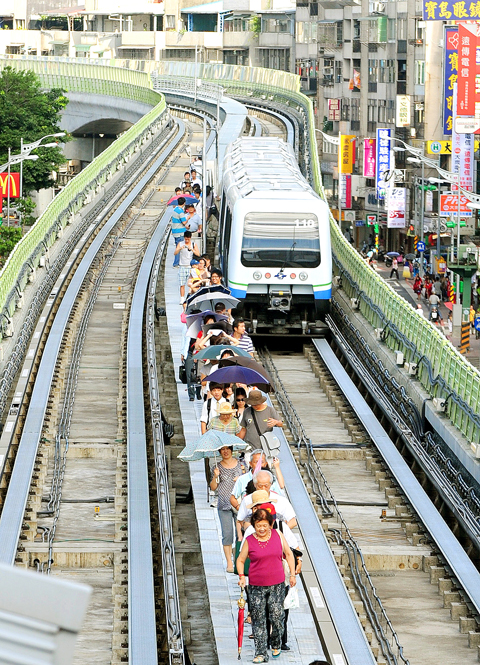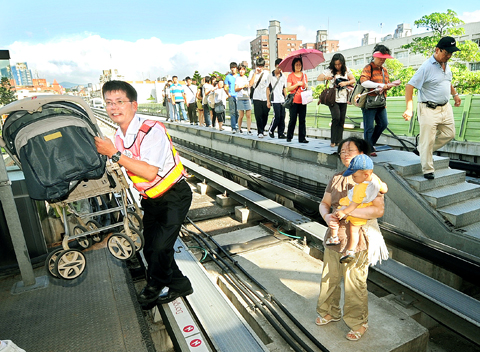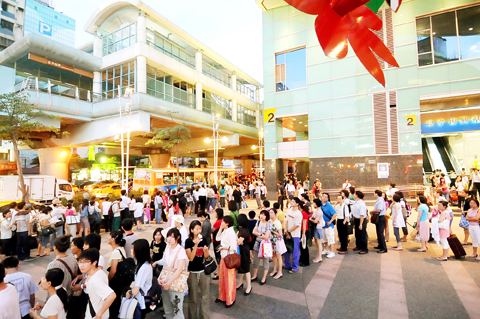The Taipei City MRT’s Neihu and Muzha lines were suspended yesterday afternoon after a sudden power outage, forcing about 700 passengers to walk down the elevated rail lines to return to station platforms after trains stopped between stations.
The lines are scheduled to resume operating at 6am today. The suspension of services yesterday was the first serious system failure on the Neihu Line since it began operations last Saturday.
A total of 21 trains running on the two lines came to a halt at 3:27pm after the control center detected a warning signal indicating a malfunction in the power supply, Taipei Rapid Transit Corp (TRTC) general manager Tsay Huei-sheng (蔡輝昇) said.

PHOTO: FANG PIN-CHAO, TAIPEI TIMES
The malfunction caused power to be cut off and the whole Brown Line was shut down, Tsay said. The company began evacuating passengers according to emergency procedures at 3:44pm after it failed to restore power, he said.
TRTC said only three trains stopped between stations — one between Neihu District’s Gangqian and Wende stations; one between Zhongshan District’s Dazhi and Jiannan stations; and one between Zhongshan District’s Zhongshan Junion High School and Songshan Airport stations.
However, Taipei Times reporters saw another train stopped between Gangqian and Wende stations, and trains stopped in both directions north of Zhongshan Junior High School Station. The TRTC declined to comment on the discrepancy.

PHOTO: FANG PIN-CHAO, TAIPEI TIMES
All passengers, including those on the trains that stopped between stations, were evacuated by 4:20pm, and the company provided free shuttle buses along the lines to take them to their destinations, Tsay said, adding that the TRTC had sent staff to evacuate passengers as soon as possible.
Some passengers from the stranded trains, however, slammed the TRTC for failing to respond to the incident promptly, leaving some waiting inside the cars for more than half an hour without air conditioning or any explanation.
“Nobody told us what happened and we were stuck inside the cars without air conditioning. Their emergency response ability is a joke,” a female passenger complained after walking back to Zhongshan Junior High School Station.

PHOTO: LU CHUN-WEI, TAIPEI TIMES
STRANDED
A Taipei Times editor, who was in the stranded train near Gangqian Station, said that passengers arriving at the station prior to the power shutdown were not able to board or alight because the doors did not open. The train then moved off and stopped a few seconds later well beyond the station. After a few moments, it started again, but then lurched to a halt, pitching passengers forward.
An announcement came over the loudspeaker that there had been an incident and that passengers should wait. Announcements, repeated every few minutes, were in Mandarin only. Several announcements were made over the next 20 minutes requesting that passengers wait “patiently.” At 25 minutes, the power and air conditioning suddenly went off. There was no announcement as to how long passengers would be expected to wait. After 30 minutes, and after receiving no instructions from MRT staff, three male passengers pried open the doors and stepped outside.
A female MRT employee ran up to the carriage from Gangqian Station. The men asked if the passengers should get off and walk to the station. She said “yes” in an exasperated tone, as if this were obvious, despite the fact that the last instruction to be issued was “wait patiently” on their own.
The staffer disappeared and no one else came to assist. Passengers alighted from the carriage, helping the infirm and elderly, before walking slowly between the two tracks back to the station. The sheer number of passengers meant that it took at least 20 minutes for them to reach Gangqian Station, no more than 200m away.
APOLOGY
Later yesterday, Taipei Mayor Hau Lung-bin (郝龍斌) apologized for the inconvenience the incident had caused the public, and demanded that Taipei city’s Department of Rapid Transit System solve the false alarms and malfunctions that have hindered the Neihu Line since its operation began less than a week ago.
“We are prioritizing our efforts on fixing the system’s false alarms and stabilizing it in the shortest time,” Hau said.
Hau acknowledged the problematic system integration of the Neihu and Muzha lines could be the reason behind the frequent malfunctions and the shutdown of the lines yesterday, but said the city government did not plan to halt the operation of the two lines to fix the problem.
The Neihu Line, an extension of the Muzha Line, was designed to be compatible with the Muzha Line’s Matra system. The Neihu Line’s builder, Montreal-based Bombardier, sent software engineers to inspect the computer systems and improve the detection of false alarms last month.
Hau said the city government would ask Bombardier for compensation according to contract if the company fails to solve the system malfunctions.
Department Commissioner Tom Chang (常歧德) said his department and Bombardier were working to fix the problems and seeking to have the lines resume operation as soon as possible.
In compensation, the firm gave free one-day MRT passes and bus tickets to passengers who had to walk along the tracks to get back to the stations. The Taipei City’s Transportation Department will continue to provide free shuttle buses along the lines today, Tsay said.

The US government has signed defense cooperation agreements with Japan and the Philippines to boost the deterrence capabilities of countries in the first island chain, a report by the National Security Bureau (NSB) showed. The main countries on the first island chain include the two nations and Taiwan. The bureau is to present the report at a meeting of the legislature’s Foreign Affairs and National Defense Committee tomorrow. The US military has deployed Typhon missile systems to Japan’s Yamaguchi Prefecture and Zambales province in the Philippines during their joint military exercises. It has also installed NMESIS anti-ship systems in Japan’s Okinawa

‘WIN-WIN’: The Philippines, and central and eastern European countries are important potential drone cooperation partners, Minister of Foreign Affairs Lin Chia-lung said Minister of Foreign Affairs Lin Chia-lung (林佳龍) in an interview published yesterday confirmed that there are joint ventures between Taiwan and Poland in the drone industry. Lin made the remark in an exclusive interview with the Chinese-language Liberty Times (the Taipei Times’ sister paper). The government-backed Taiwan Excellence Drone International Business Opportunities Alliance and the Polish Chamber of Unmanned Systems on Wednesday last week signed a memorandum of understanding in Poland to develop a “non-China” supply chain for drones and work together on key technologies. Asked if Taiwan prioritized Poland among central and eastern European countries in drone collaboration, Lin

NO CONFIDENCE MOTION? The premier said that being toppled by the legislature for defending the Constitution would be a democratic badge of honor for him Premier Cho Jung-tai (卓榮泰) yesterday announced that the Cabinet would not countersign the amendments to the local revenue-sharing law passed by the Legislative Yuan last month. Cho said the decision not to countersign the amendments to the Act Governing the Allocation of Government Revenues and Expenditures (財政收支劃分法) was made in accordance with the Constitution. “The decision aims to safeguard our Constitution,” he said. The Constitution stipulates the president shall, in accordance with law, promulgate laws and issue mandates with the countersignature of the head of the Executive Yuan, or with the countersignatures of both the head of the Executive Yuan and ministers or

CABINET APPROVAL: People seeking assisted reproduction must be assessed to determine whether they would be adequate parents, the planned changes say Proposed amendments to the Assisted Reproduction Act (人工生殖法) advanced yesterday by the Executive Yuan would grant married lesbian couples and single women access to legal assisted reproductive services. The proposed revisions are “based on the fundamental principle of respecting women’s reproductive autonomy,” Cabinet spokesperson Michelle Lee (李慧芝) quoted Vice Premier Cheng Li-chiun (鄭麗君), who presided over a Cabinet meeting earlier yesterday, as saying at the briefing. The draft amendment would be submitted to the legislature for review. The Ministry of Health and Welfare, which proposed the amendments, said that experts on children’s rights, gender equality, law and medicine attended cross-disciplinary meetings, adding that